This article lists all electronically published NASA reports on sparless parawings. In the reports these parawings are described as "all-flexible" or "tension-structure" to differentiate them from the versions which have inflatable or solid members along keel or edges. Reports are listed by publication date, earliest first. NASA was interested this type of parawing design for Apollo capsule recovery. The graphic in each section is taken from the associated entry.
These reports can be found by going to the NASA Technical Reports Server and searching for the report number.
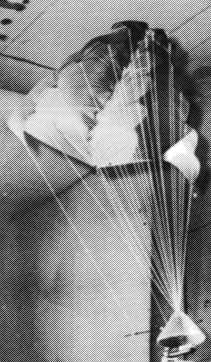 Title: Resume of recent parawing research
Title: Resume of recent parawing researchAuthors: Francis M. Rogallo, William C. Sleeman Jr., Delwin R. Croom
NASA Center: Langley Research Center
Publication Date: July, 1965
Report Number: TMX-56747
File: 19660017784_1966017784.pdf
Pages: 38
Summary: Graphic showing limp paragliders will have a maximum L/D of 3, and a structurally stiffened version will have a L/D of 6. Covers conical versus cylindrical wings.
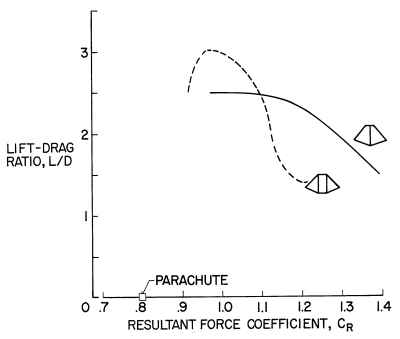 Title: NASA Research on Flexible Wings
Title: NASA Research on Flexible WingsAuthors: Francis M. Rogallo
NASA Center: Langley Research Center
Publication Date: January, 1967
Report Number: NASA TM X-59738
File: 19680015821_1968015821.pdf
Pages: 20
Summary: History and evaluation of parawing development.
"After the usual dreaming about flexible wings since childhood, the author in 1945 at the close of World War II decided to undertake a serious study of the subject. Because pressure of work along more conventional lines did not permit such a study to be made on government time, it was decided to undertake it at home jointly with Mrs. Rogallo and later including other members of the family and friends. This private endeavor covered the 13 years from 1945 until late in 1958, when America's entry into the exploration of space brought about government consideration of this and other unconventional ideas and the subsequent formation of what is now officially the Flexible-Wing Section of Langley Research Center, a truly dedicated group."
"In the pre-NASA years the wing was called a kite because of the three experimental methods used: testing in a homemade wind tunnel, free flying as hand-launched gliders, and tethered outdoor flying as kites."
"The maximum lift-drag ratio of the single-keel wing shown is about 2.5 while that of the twin-keel wing is about 3."
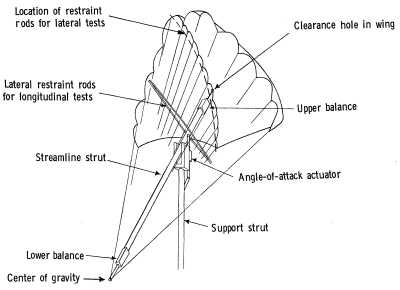 Title: Wind-tunnel investigation of the static aerodynamic characteristics of an 18-foot (5.49-meter) all-flexible parawing
Title: Wind-tunnel investigation of the static aerodynamic characteristics of an 18-foot (5.49-meter) all-flexible parawingAuthors: Charles E. Libbey, George M. Ware, and Rodger L. Naeseth
NASA Center: Langley Research Center
Publication Date: June, 1967
Report Number: NASA TN D-3856
File: 19670017942_1967017942.pdf
Pages: 38
Summary: Single keel parawing evaluation. "One concept in the gliding parachute category which has received considerable attention is a parawing completely void of any rigid structural members and utilizing only the tension forces produced by the aerodynamic loading to maintain the shape of the canopy. This device, which was developed at the NASA Langley Research Center, is called an all-flexible parawing."
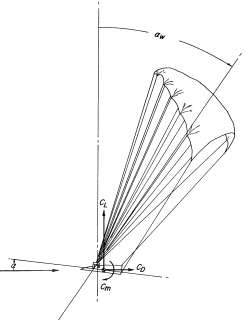 Title: Low-speed tests of an all-flexible parawing for landing a lifting-body spacecraft
Title: Low-speed tests of an all-flexible parawing for landing a lifting-body spacecraftAuthors: Frank M. Bugg and William C. Sleeman, Jr.
NASA Center: Langley Research Center
Publication Date: June, 1967
Report Number: NASA TN D-4010
File: 19670019428_1967019428.pdf
Pages: 35
Summary: Wind tunnel and free flight tests of a single keel parawing. A L/D of 2.5 was measured.
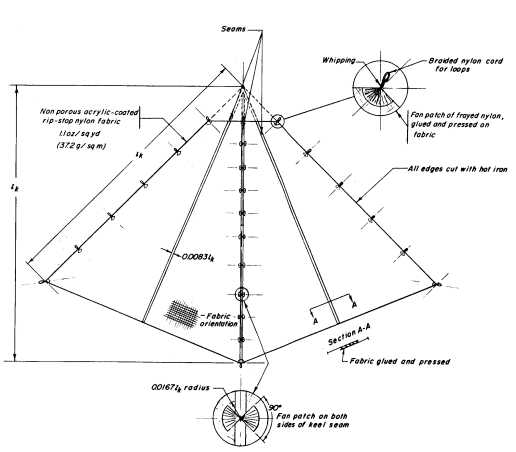 Title: Low-speed wind-tunnel investigation of tension-structure parawings
Title: Low-speed wind-tunnel investigation of tension-structure parawingsAuthors: Rodger L. Naeseth and Paul G. Fournier
NASA Center: Langley Research Center
Publication Date: June, 1967
Report Number: NASA TN D-3940
File: 19670023418_1967023418.pdf
Pages: 192
Summary: A comparison of many variations on the one keel model.
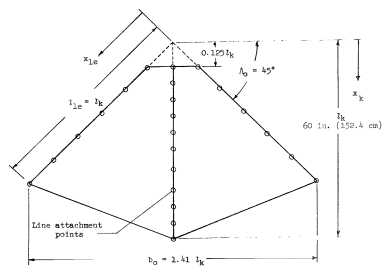 Title: Investigation of opening characteristics of an all-flexible parawing
Title: Investigation of opening characteristics of an all-flexible parawingAuthor: Thomas G. Gainer
NASA Center: Langley Research Center
Publication Date: February, 1969
Report Number: NASA TN D-5031
File: 19690008368_1969008368.pdf
Pages: 33
Summary: Wind tunnel tests of opening forces.
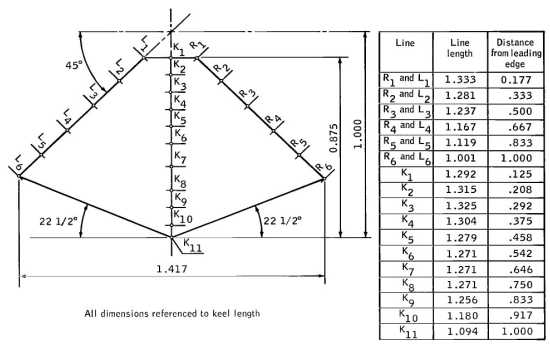 Title: Experimental verification of scale factors for parawing opening
Title: Experimental verification of scale factors for parawing openingcharacteristics with dimensional ratios from 1:1.3 to 1:3
Authors: Robert H. Moore, David L. Eichblatt, and Theodore F. Hughes
NASA Center: Johnson Space Center
Publication Date: March, 1969
Report Number: NASA TN D-5071
File: 19690010596_1969010596.pdf
Pages: 43
Summary: One keel model tests. "Three scaled, all-flexible parawings were tested: a scale model having a keel length of 8 feet and a payload of 5 pounds, an intermediate-scale model having a keel length of 18 feet and a payload of 78 pounds, and a full-scale model having a keel length of 24 feet and a payload of 191 pounds. Dimensions and weights were scaled to obtain corresponding dynamic similarity. The parawings were deployed from an initial packed condition and at various initial velocities."
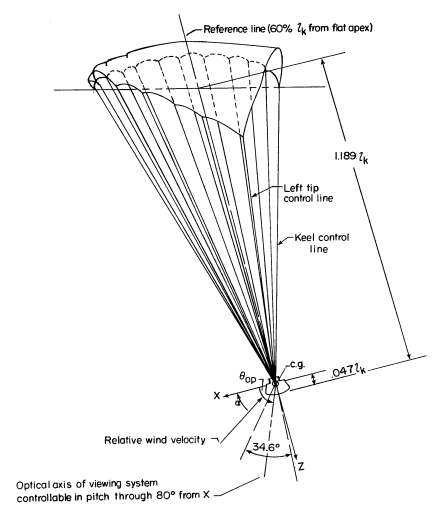 Title: Fixed-base visual simulation of pilot controlled descents of an advanced
Apollo spacecraft with an all-flexible parawing
Title: Fixed-base visual simulation of pilot controlled descents of an advanced
Apollo spacecraft with an all-flexible parawingAuthors: G. Kimball Miller, Jr., Byron M. Juquet, Douglas B. Price
NASA Center: Langley Research Center
Publication Date: March, 1969
Report Number: NASA TN D-5049
File: 19690011574_1969011574.pdf
Pages: 63
Summary: Optical simulation landing system for evaluating pilot controlled flexible parawing and Apollo capsule combination performance during landing.
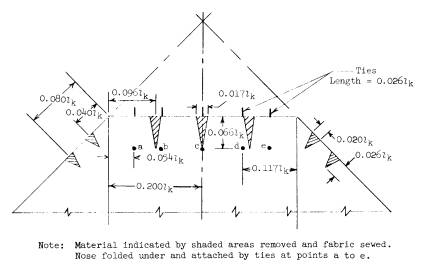 Title: Wind-tunnel investigation of the aerodynamic characteristics of a
twin-keel parawing
Title: Wind-tunnel investigation of the aerodynamic characteristics of a
twin-keel parawingAuthor: George M. Ware
NASA Center: Langley Research Center
Publication Date: May, 1969
Report Number: NASA TN D-5199
File: 19690014403_1969014403.pdf
Pages: 32
Summary: The first report on a twin keel parawing. "Changing the length of the aft-keel and wing-tip lines was effective in trimming the model over the entire unstalled angle-of-attack range and resulted in a modulation in lift-drag ratio from 2.2 to 3.4."
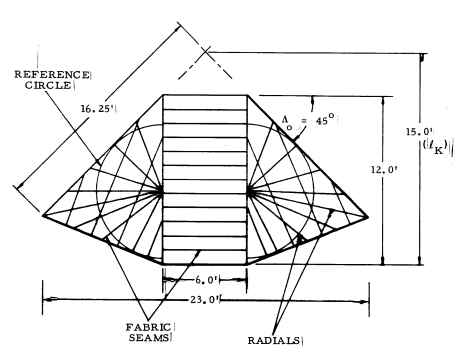 Title: Wind tunnel and free flight investigation of all-flexible parawings at
small scale
Title: Wind tunnel and free flight investigation of all-flexible parawings at
small scaleAuthors: Buhler, W. C.; Linhart, E. M.
NASA Center: NORTHROP CORPORATION, VENTURA DIVISION
Publication Date: May, 1969
Report Number: NASA CR-66879; NVR-6366A
File: 19700010491_1970010491.pdf
Pages: 214
Summary: Wind tunnel, gliding, and deployment tests of all-flexible, single keel and double keel parawing models. "Two parawing designs were tested: the single keel and the twin keel models. Maximum lift-to-drag ratios measured in wind tunnel tests were in the range of 2.5 to 2.7 for the single keel models and 3.2 to 3.4 for the twin keel models. Free flight gliding tests indicated maximum lift-to-drag ratios 10 to 15 percent less than those measured in the wind tunnels, due at least in part to the added drag of the test vehicles. Wind tunnel tests showed that maximum lift-to-drag ratio is strongly influenced by the length of the tip suspension lines for a given line length rigging, both for single keel and twin keel models."
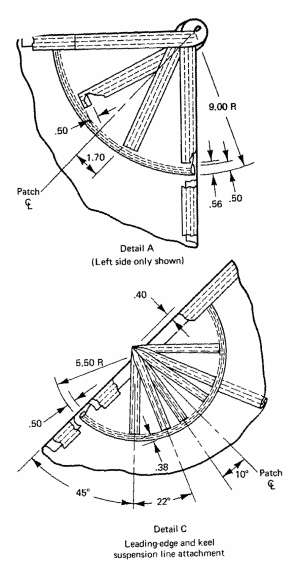 Title: Wind-tunnel investigation of several large-scale all-flexible parawings
Title: Wind-tunnel investigation of several large-scale all-flexible parawingsAuthors: Michael D. Falarski, Kenneth W. Mort
NASA Center: Ames Research Center
Publication Date: March, 1970
Report Number: A-3190; NASA TN D-5708
File: 19700011304_1970011304.pdf
Pages: 43
Summary: Wind tunnel tests of large scale all-flexible parawings. Construction details for both single and dual keel.
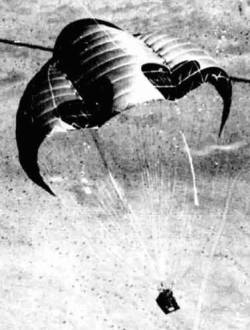 Title: Free flight investigation of large all-flexible parawings and performance
comparison with small parawings - Final report
Title: Free flight investigation of large all-flexible parawings and performance
comparison with small parawings - Final reportAuthors: Gran, W. M.; Linhart, E. M.; Moeller, J. H.; Parson, L. T.
NASA Center: NORTHROP CORPORATION, VENTURA DIVISION
Publication Date: March, 1970
Report Number: NASA CR-66918
File: 19700015766_1970015766.pdf
Pages: 302
Summary: Free flight testing of large all-flexible parawings and performance comparison with small parawings to provide land-landing capability for manned spacecraft. Models also had lines to trailing edge. Curved nose to wing seam.
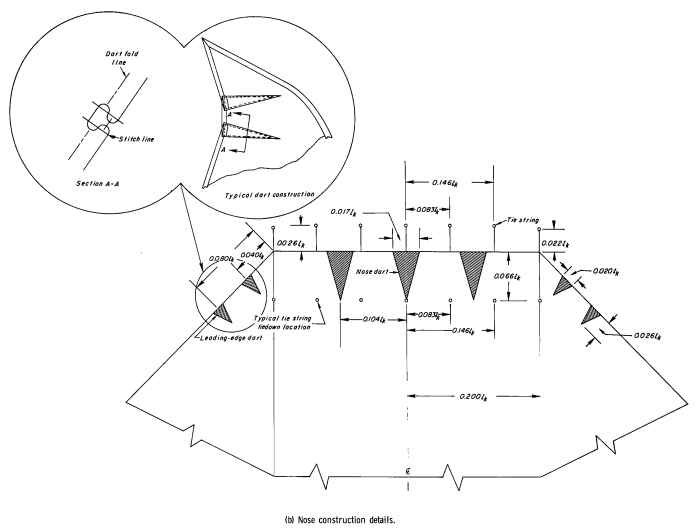 Title: Performance and deployment characteristics of a twin-keel parawing
with various amounts and permeabilities of porous material in outer lobes
Title: Performance and deployment characteristics of a twin-keel parawing
with various amounts and permeabilities of porous material in outer lobesAuthors: Harry L. Morgan, Jr.
NASA Center: Langley Research Center
Publication Date: May, 1970
Report Number: L-6961; NASA TN D-5793
File: 19700017675_1970017675.pdf
Pages: 41
Summary: Performance and deployment characteristics of twin-keel parawing with different amounts and permeabilities of porous material in outer lobes. "The test results indicated that the addition of the various amounts and permeabilities of porous materials had little effect on the deployment loads but caused a reduction in flight performance. The increase in permeability caused a reduction in the maximum obtainable lift-drag ratio from 2.90 to 2.13."
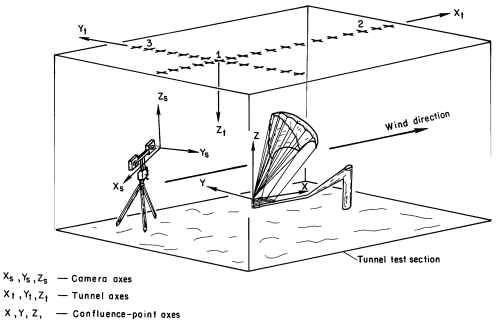 Title: Determination of inflated shape and inertial properties of an
all-flexible parawing
Title: Determination of inflated shape and inertial properties of an
all-flexible parawingAuthor: Blair B. Gloss
NASA Center: Langley Research Center
Publication Date: July, 1970
Report Number: L-6906; NASA TN D-5900
File: 19700022948_1970022948.pdf
Pages: 34
Summary: Single keel study by measuring shape. "Nondimensional inertial properties were calculated from the shape data. These non-dimensional inertias can be scaled to any geometrically similar single-keel, all-flexible parawing with a 45 degree leading-edge sweep and with any weight canopy and any weight suspension lines. The center of gravity of the system was calculated from the shape data and was found to rotate about the confluence point with changes in lift-drag ratio."
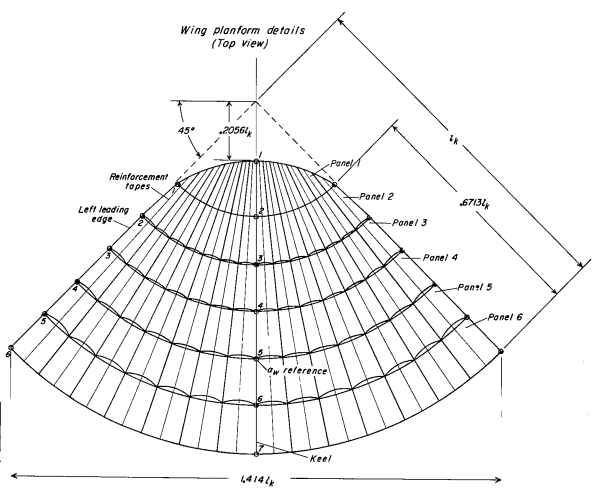 Title: Aerodynamic and deployment characteristics of single-keel
solid and single-keel slotted personnel parawings
Title: Aerodynamic and deployment characteristics of single-keel
solid and single-keel slotted personnel parawingsAuthors: Harry L. Morgan, Jr., Charles F. Bradshaw
NASA Center: Langley Research Center
Publication Date: July, 1970
Report Number: L-6590; NASA TN D-5911
File: 19700023533_1970023533.pdf
Pages: 38
Summary: Experiments with single-keel solid and single-keel slotted parawings of suitable size for use in personnel recovery systems.
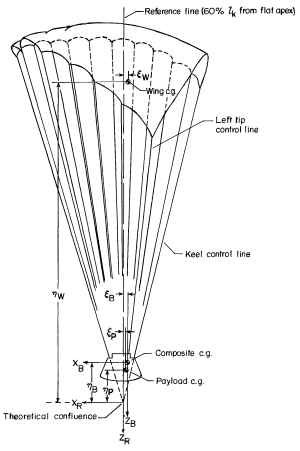 Title: Fixed-base visual simulation of obstacle avoidance during terminal
descent of advanced Apollo spacecraft with an all-flexible parawing
Title: Fixed-base visual simulation of obstacle avoidance during terminal
descent of advanced Apollo spacecraft with an all-flexible parawingAuthor: G. Kimball Miller, Jr.
NASA Center: Langley Research Center
Publication Date: August, 1970
Report Number: L-7116; NASA TN D-5940
File: 19700026611_1970026611.pdf
Pages: 52
Summary: Fixed-base visual simulation study for ability determination of onboard pilot during landing.
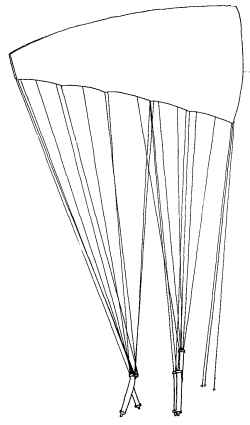 Title: Model wind-tunnel and flight investigation of a parawing lifting body
landing system
Title: Model wind-tunnel and flight investigation of a parawing lifting body
landing systemAuthor: Rodger L. Naeseth
NASA Center: Langley Research Center
Publication Date: October, 1970
Report Number: L-6995; NASA TN D-5893
File: 19700031351_1970031351.pdf
Pages: 95
Summary: Wind tunnel model and flight tests of single keel parawing lifting body landing system.
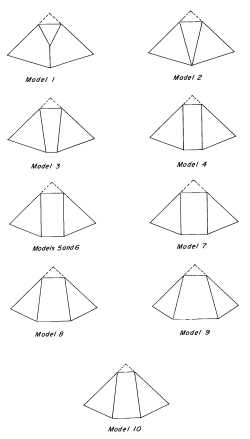 Title: Low-speed wind-tunnel investigation of a series of twin-keel
all-flexible parawings
Title: Low-speed wind-tunnel investigation of a series of twin-keel
all-flexible parawingsAuthor: Rodger L. Naeseth
NASA Center: Langley Research Center
Publication Date: October, 1970
Report Number: L-7096; NASA TN D-5936
File: 19710000578_1971000578.pdf
Pages: 104
Summary: Describes models 1-10. "The maximum lift-drag ratios of the models ranged from 2.6 to 3.2. Results of a limited flight-test program indicated that the twin- keel parawings would glide when the rigging) except for control-line length, was set as determined in the small-scale wind-tunnel tests."
More details on this report can be found on the Nasa Parawing Research page.
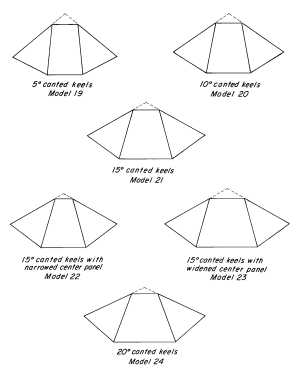 Title: Low-speed wind-tunnel investigation of all-flexible twin-keel
tension-structure parawings
Title: Low-speed wind-tunnel investigation of all-flexible twin-keel
tension-structure parawingsAuthor: Paul G. Fournier
NASA Center: Langley Research Center
Publication Date: October, 1970
Report Number: L-7035; NASA TN D-5965
File: 19700031372_1970031372.pdf
Pages: 87
Summary: Describes twin keels models 17-24. "For a keel-payload separation distance of approximately 1.00 keel length, values of maximum lift-drag ratio increased from 2.78 to 3.27 as the keel cant angle was varied from 0° to 15°. Values of maximum lift-drag ratio decreased when the cant angle of the keels was increased from 15° to 20°. Increasing the keel-payload separation to 1.25 keel length increased the maximum lift-drag ratio of the model with 15° cant angle to a value of 3.41. A modification to the line attachment at the formed nose on the center panel of this parawing increased the maximum lift-drag ratio to 3.48."
More details on this report can be found on the Nasa Parawing Research page.
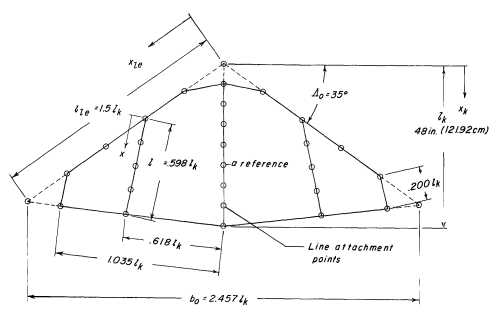 Title: Wind tunnel studies of effects of construction methods, design
details, and canopy slots on the aerodynamic characteristics of
small-scale all-flexible parawings
Title: Wind tunnel studies of effects of construction methods, design
details, and canopy slots on the aerodynamic characteristics of
small-scale all-flexible parawingsAuthors: Paul G. Fourier and William C, Sleeman, Jr.
NASA Center: Langley Research Center
Publication Date: October, 1970
Report Number: L-7013; NASA TN D-5974
File: 19700031435_1970031435.pdf
Pages: 94
Summary: Wind tunnel test of canopy construction methods, design details, and canopy slots. "The maximum lift-drag ratios varied from 2.2 to 2.5 for the various single-keel unslotted parawings, and from 2.2 to 2.4 for the slotted canopy parawings." Shape experiments: composite wing, swept wing, rectangular wing.
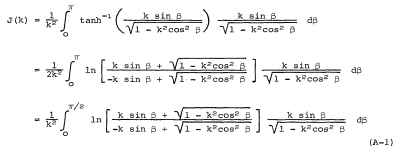 Title: An exploratory aerodynamic and structural investigation of
all-flexible parawings
Title: An exploratory aerodynamic and structural investigation of
all-flexible parawingsAuthor(s): Lee, A. L.; Nielson, J. N.; Spangler, S. B.; Stahara, S. S.
NASA Center: NIELSEN NENGINEERING & RESEARCH, INC.
Publication Date: December, 1970
Report Number: NASA CR-1674; NEAR-TR-20
File: 19710003929_1971003929.pdf
Pages: 159
Summary: Mathematics of parawings.
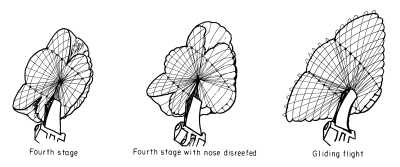 Title: Aerodynamic and deployment characteristics of multistage canopy
and suspension-line reefing systems for a twin-keel all-flexible parawing
Title: Aerodynamic and deployment characteristics of multistage canopy
and suspension-line reefing systems for a twin-keel all-flexible parawingAuthors: Harry L. Morgan, Jr., Austin D. McHatton
NASA Center: Langley Research Center
Publication Date: July, 1971
Report Number: L-7567; NASA TN D-6306
File: 19710021272_1971021272.pdf
Pages: 65
Summary: Aerodynamic and deployment characteristics of twin keel all-flexible parawing rigged with several variations of multistage canopy and suspension line reefing system.
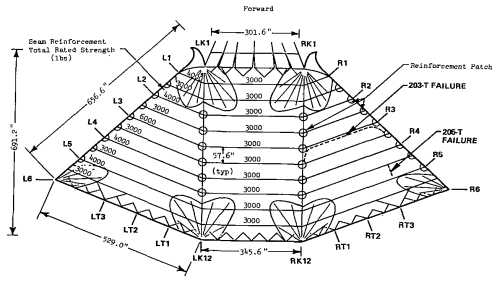 Title: Geometric, aerodynamic, and kinematic characteristics of two twin keel
parawings during deployment
Title: Geometric, aerodynamic, and kinematic characteristics of two twin keel
parawings during deploymentAuthors: Paul M . Kenner, Frederic T. Churchill, and Ralph B. Holt
NASA Center: LTV AEROSPACE CORPORATION
Publication Date: August, 1971
Report Number: NASA CR-1788
File: 19710022827_1971022827.pdf
Pages: 70
Summary: Twin keel deployment tests.
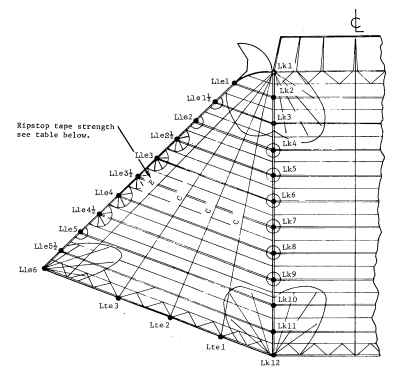 Title: Deployment loads data from a free-flight investigation of all flexible
parawings having 371.612 sq meters (4000 sq feet) of wing area
Title: Deployment loads data from a free-flight investigation of all flexible
parawings having 371.612 sq meters (4000 sq feet) of wing areaAuthor: Delwin R. Croom
NASA Center: Langley Research Center
Publication Date: November 1971
File: 19720004307_1972004307.pdf
Pages: 512
Summary: A free-flight test program to determine the deployment characteristics of all-flexible parawings was conducted. Several twin-keel-parawing tests were also made by using an instrumented controllable sled-type test vehicle. The systems were launched from either a C-130 or a C-119 carrier airplane, and a programer parachute was used to bring the test vehicle to a proper dynamic pressure and near-vertical flight path prior to deployment of the parawing system. The free-flight deployment loads data are presented in the form of time histories of individual suspension-line loads and total loads.
Notes
These reports can be found by going to the NASA Technical Reports Server and searching for the report number. Direct links are included here for convenience, based on NASA's copyright policy: "Documents available from [NASA's] web site are not protected by copyright unless noted. If not copyrighted, documents may be reproduced and distributed, without further permission from NASA." If you have access to original reports, better scans, or parawing reports not listed here, please contact me.
Later large scale NPW twin keel models show different nose construction details than the earlier models. It appears the later models used a curved seam to connect the top part of the wing to the nose. However, this shape could also be the artists rendition of the post notch modification shape of the top part of the wing panel.
Filenames use a date format. The filename of NASA TN D-5936 (description of models 1-10) is later than NASA TN D-5965 (description of twin keel models 17-24).
The earliest report emphasized the lift-drag advantage of cylindrical wing shapes. Later reports, NASA TN D-5965 in particular show canted keels provide the best performance.
Many interesting sparless single skin planforms were investigated, not just single and twin keel models. See, e.g., NASA TN D-5974 for examples of four lobed models, rectangular models, etc.
As noted in the Nasa Parawing Research page, model numbers 11-16 don't seem to be described anywhere. D-5965 (describing 17-24) references D-5936 (describing models 1-10), but does not reference any reports which describe models 11-16.